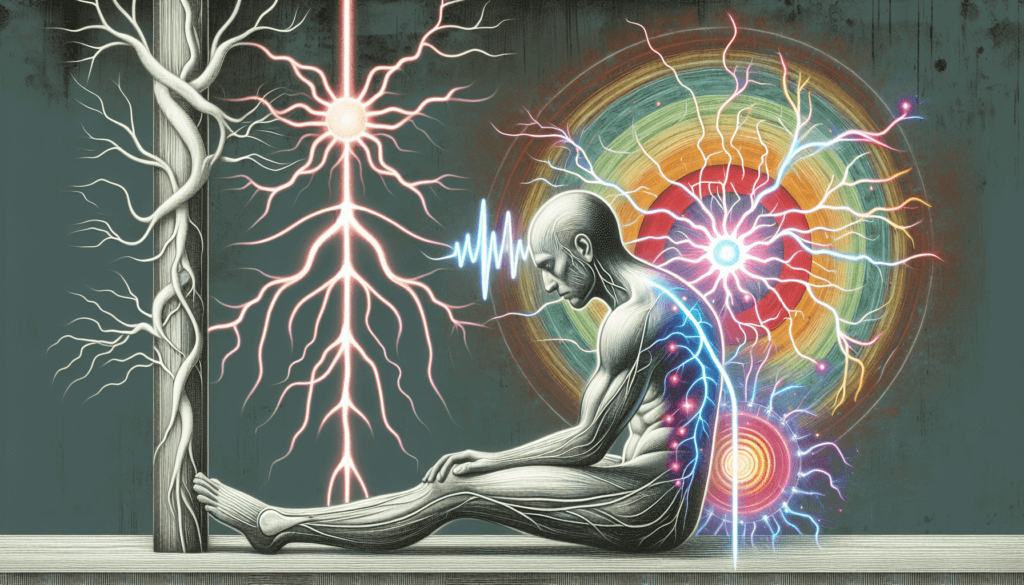Have you been struggling with neuropathy and searching for an effective treatment? Look no further! In this article, we will explore the exciting world of Pemf therapy and its potential benefits for neuropathy. Pemf therapy, also known as Pulsed Electromagnetic Field therapy, utilizes electromagnetic fields to stimulate the body’s natural healing processes. With growing evidence supporting its effectiveness, Pemf therapy may just be the solution you’ve been waiting for to alleviate the symptoms of neuropathy and improve your quality of life. So, let’s dive into the fascinating realm of Pemf therapy and discover the possibilities it holds for those experiencing neuropathy.

What is PEMF Therapy?
Definition of PEMF therapy
PEMF therapy stands for Pulsed Electromagnetic Field therapy. It is a non-invasive and drug-free treatment that uses electromagnetic fields to promote healing and provide relief from various health conditions, including neuropathy.
PEMF therapy involves the use of a PEMF device, which emits electromagnetic pulses that penetrate the body’s tissues at a cellular level. These pulses generate microcurrents, similar to the natural electrical signals produced by the body, to stimulate cellular repair and regeneration.
Mechanism of action
The mechanism of action of PEMF therapy revolves around the interaction between the electromagnetic fields and the body’s cells. When exposed to PEMF, the cells in the body absorb the energy from the magnetic fields, leading to a series of physiological responses.
The electromagnetic pulses stimulate the production of adenosine triphosphate (ATP), which is responsible for cellular energy production. This increased ATP production promotes cell metabolism and enhances the body’s natural healing processes.
Furthermore, PEMF therapy helps to balance the electrical charge of cells, improve circulation, increase oxygenation, and facilitate the elimination of waste products. These effects contribute to reducing inflammation, relieving pain, and promoting nerve regeneration.
Benefits of PEMF therapy
PEMF therapy has shown promising results in the treatment of neuropathy, offering several benefits for individuals suffering from this condition. Some key benefits of PEMF therapy for neuropathy include:
- Pain relief: PEMF therapy can help alleviate the chronic pain associated with neuropathy by reducing inflammation and restoring proper nerve function.
- Nerve regeneration: By stimulating nerve growth and repair, PEMF therapy aids in the regeneration of damaged nerves, leading to improved sensory and motor functions.
- Enhanced blood flow: PEMF therapy improves microcirculation, increasing the delivery of oxygen and nutrients to damaged nerve tissues, further supporting the healing process.
- Reduced medication dependency: As PEMF therapy addresses the underlying causes of neuropathy, it may reduce the need for pain medications and provide a non-pharmacological alternative for symptom management.
- Non-invasive and safe: PEMF therapy is a non-invasive treatment option that poses minimal risks or side effects, making it suitable for individuals seeking a conservative approach to managing neuropathy symptoms.
Understanding Neuropathy
Definition of neuropathy
Neuropathy, also known as peripheral neuropathy, refers to a condition characterized by damage or dysfunction of the peripheral nerves, which communicate information between the brain and the rest of the body. It can affect a single nerve or a group of nerves and often leads to symptoms such as numbness, tingling, weakness, and pain in the affected areas.
Causes of neuropathy
Neuropathy can be caused by various factors, including:
- Diabetes: Diabetes is a common cause of neuropathy, with prolonged high blood sugar levels leading to nerve damage.
- Trauma: Physical injuries, such as falls or accidents, can result in nerve damage and subsequent neuropathy.
- Vitamin deficiencies: Lack of essential vitamins, particularly B vitamins, can contribute to nerve damage and neuropathy.
- Autoimmune disorders: Conditions like rheumatoid arthritis, lupus, and Guillain-Barre syndrome can cause inflammation and damage to the peripheral nerves.
- Medications and toxins: Certain medications, including chemotherapeutic drugs, and exposure to toxins like heavy metals can lead to nerve damage and neuropathy.
Symptoms of neuropathy
The symptoms of neuropathy can vary depending on the specific nerves affected and the underlying cause. Common signs and symptoms of neuropathy may include:
- Numbness or tingling in the hands or feet
- Sharp or burning pain in the affected areas
- Muscle weakness and difficulty in coordination
- Sensitivity to touch or temperature changes
- Loss of reflexes
- Balance problems and increased risk of falls
It is important to consult a healthcare professional if you experience these symptoms to receive a proper diagnosis and determine the most appropriate treatment options, including PEMF therapy.
How PEMF Therapy Works for Neuropathy
Effect of PEMF therapy on nerves
PEMF therapy directly targets the affected nerves in neuropathy, providing a therapeutic stimulus that promotes nerve regeneration and repair. The electromagnetic fields generated by the PEMF device penetrate deep into the tissues and create a favorable environment for nerve cells to heal.
The pulsed electromagnetic fields stimulate the nerve cells, triggering biochemical and physiological responses that aid in repairing damaged nerves. This stimulation promotes cellular metabolism, ATP production, and protein synthesis, which are essential for nerve regeneration and growth.
Stimulating nerve regeneration
Nerve regeneration is a complex process that requires the growth and guidance of new nerve fibers to reconnect and restore function. PEMF therapy has been shown to facilitate this process by promoting the expression of growth factors and enhancing the communication between nerve cells.
The electromagnetic pulses emitted by the PEMF device encourage the production of nerve growth factors, such as brain-derived neurotrophic factor (BDNF) and glial cell line-derived neurotrophic factor (GDNF). These growth factors play a crucial role in the regeneration and survival of nerve cells, helping to restore damaged nerve fibers.
Reducing pain and inflammation
In neuropathy, chronic pain and inflammation are common symptoms that significantly impact individuals’ quality of life. PEMF therapy can help alleviate these symptoms by reducing inflammation and increasing the production of endorphins, the body’s natural painkillers.
The electromagnetic fields emitted by the PEMF device promote the production of nitric oxide, a molecule that acts as a vasodilator and anti-inflammatory agent. This increased nitric oxide production improves blood circulation, reduces inflammation, and relieves pain associated with neuropathy.
Additionally, PEMF therapy helps to modulate the transmission of pain signals, providing relief from neuropathic pain by interrupting the pain pathways and promoting the release of endorphins, which act as natural pain relievers.
Research on PEMF Therapy for Neuropathy
Scientific studies and findings
Multiple scientific studies have been conducted to investigate the efficacy of PEMF therapy for neuropathy. These studies have provided valuable insights into the potential benefits of this non-invasive treatment approach.
Research published in the Journal of Rehabilitation Medicine showed that PEMF therapy significantly improved pain scores in individuals with diabetic neuropathy compared to a placebo group. The findings indicated that PEMF therapy offered a promising alternative for pain management in diabetic neuropathy.
Another study published in The Journal of Alternative and Complementary Medicine demonstrated that PEMF therapy improved both subjective and objective measures of neuropathy, including pain, sensation, and nerve conduction velocity.
Evidence-based results
The evidence from these studies supports the use of PEMF therapy as a viable treatment option for neuropathy. The results consistently demonstrate the positive effects of PEMF therapy in reducing pain, improving sensory function, and enhancing nerve conduction.
While more research is still needed to further establish the long-term benefits and optimal treatment protocols, the current evidence provides a solid foundation for considering PEMF therapy as a valuable intervention for neuropathy management.
Success stories and testimonials
In addition to scientific studies, numerous success stories and testimonials from individuals who have undergone PEMF therapy for neuropathy further emphasize its potential effectiveness. Many individuals have reported significant improvements in pain relief, increased sensation, and enhanced overall quality of life following PEMF treatment.
These firsthand accounts provide a valuable perspective on the real-life benefits experienced by neuropathy patients through the use of PEMF therapy. While individual experiences may vary, the positive testimonials add to the growing body of evidence supporting the effectiveness of PEMF therapy for neuropathy.

Choosing the Right PEMF Device
Factors to consider when selecting a device
When considering PEMF therapy for neuropathy, it is essential to choose the right PEMF device that suits your specific needs and offers optimal results. Here are some factors to consider when selecting a PEMF device:
- Power and intensity: Look for a device that provides sufficient power and intensity settings to deliver effective treatment to the affected nerves.
- Frequency range: Different frequencies have varying effects on the body, so choose a device with a broad frequency range to target different aspects of nerve regeneration and pain relief.
- Portability and convenience: Consider whether you require a portable device that can be used at home or on the go, or if a larger, clinic-based device is more suitable.
- User interface and controls: Opt for a device with a user-friendly interface and controls that allow for easy adjustment of settings and treatment protocols.
- Accessories and additional features: Some devices come with additional features or accessories like applicators or mats for targeting specific areas or offering a more comprehensive treatment experience.
Quality and safety certifications
When selecting a PEMF device, it is crucial to ensure that it meets quality and safety standards. Look for devices that have been tested and certified by reputable organizations or regulatory agencies, such as the Food and Drug Administration (FDA) in the United States or the European Medicines Agency (EMA) in Europe.
Certifications provide assurance that the device has undergone rigorous testing for safety, effectiveness, and compliance with relevant regulations. This ensures that you are using a reliable and trustworthy device for your neuropathy treatment.
User-friendly features
User-friendly features can greatly enhance your experience with PEMF therapy. Look for devices that offer features such as pre-set treatment protocols for neuropathy, easy control settings, and clear instructions for use.
Some devices also incorporate additional convenience features like timers, automatic shut-off functions, and adjustable intensity levels. Considering these user-friendly features can make your PEMF therapy sessions more comfortable and effective, allowing you to focus on your healing and well-being.
Applying PEMF Therapy for Neuropathy
Treatment protocols and duration
The specific treatment protocols and duration for PEMF therapy in neuropathy can vary depending on the severity of the condition, individual response, and the chosen PEMF device. It is advisable to consult with a healthcare professional or a PEMF therapy practitioner to determine the most appropriate treatment plan.
Generally, PEMF therapy for neuropathy involves multiple sessions over a designated period. Each session may last from a few minutes to an hour, depending on the recommended protocol. Initially, more frequent sessions may be needed, followed by a maintenance phase where sessions can be spaced out.
Consistency is key when undergoing PEMF therapy for neuropathy, so it is important to adhere to the recommended treatment schedule to maximize the potential benefits.
Frequency and intensity settings
The frequency and intensity settings of the PEMF device play a crucial role in determining the therapeutic effects of the treatment. This is why it is essential to follow the specific guidelines provided with your chosen device or seek guidance from a healthcare professional.
Different frequencies and intensity levels may be recommended to target various aspects of neuropathy, such as pain relief, nerve regeneration, or inflammation reduction. The specific settings and adjustments should be tailored to your individual needs, ensuring that you receive the optimal therapeutic benefits of PEMF therapy for your neuropathy condition.
Maintenance and follow-up
Once you have completed the recommended course of PEMF therapy for neuropathy, it is important to maintain the progress achieved and monitor any changes in symptoms. Some individuals may require ongoing maintenance sessions to sustain the positive effects of the treatment.
Regular follow-up appointments with your healthcare professional or PEMF therapy practitioner can help track your progress, make any necessary adjustments to the treatment plan, and provide ongoing support and guidance.
Alternative Therapies for Neuropathy
Other non-invasive treatments
In addition to PEMF therapy, there are various other non-invasive treatments that can be used in combination to manage neuropathy symptoms and promote nerve regeneration. Some of these alternative therapies include:
- Transcutaneous Electrical Nerve Stimulation (TENS): TENS therapy involves using low-voltage electrical currents to alleviate pain by disrupting pain signals and stimulating the release of endorphins.
- Laser therapy: Low-level laser therapy, also known as cold laser therapy, uses low-intensity laser light to stimulate cellular activity and promote healing.
- Acupuncture: This traditional Chinese medicine technique involves inserting thin needles into specific points of the body to promote pain relief and balance the body’s energy flow.
- Massage therapy: Therapeutic massages can help improve circulation, reduce muscle tension, and relieve pain associated with neuropathy.
These alternative therapies can be used alongside PEMF therapy to enhance the overall treatment outcomes and provide a holistic approach to managing neuropathy.
Complementary therapies to enhance results
Complementary therapies can also be incorporated alongside PEMF therapy to further enhance the results and support the healing process. Some complementary therapies that can be considered include:
- Physical therapy: Physical therapy focuses on exercises and techniques to improve strength, balance, and coordination, helping to manage neuropathy symptoms and maintain mobility.
- Nutritional support: A well-balanced diet that includes essential vitamins and minerals can support nerve health and aid in the regeneration process. Consultation with a nutritionist or dietitian can provide guidance on suitable dietary choices for neuropathy.
- Mind-body techniques: Practices such as meditation, deep breathing exercises, and relaxation techniques can help reduce stress, improve sleep quality, and promote overall well-being.
These complementary therapies work synergistically with PEMF therapy to address the multiple aspects associated with neuropathy, offering a comprehensive approach to management and healing.
Combining PEMF therapy with other approaches
The combination of PEMF therapy with other therapeutic approaches can have a synergistic effect in managing neuropathy. Working in tandem, these treatments can provide a multi-faceted approach that addresses various underlying causes and symptoms.
For example, combining PEMF therapy with physical therapy can help strengthen muscles, improve balance, and enhance mobility. Additionally, incorporating nutritional support and mind-body techniques can further contribute to the overall well-being and quality of life for individuals with neuropathy.
It is essential to work with a healthcare professional or a specialized neuropathy clinic to create a customized treatment plan that suits your specific needs and maximizes the potential benefits of combining various therapies.
Safety and Precautions
Potential risks and contraindications
While PEMF therapy is generally safe and well-tolerated, there are some precautions and potential risks to be aware of. Certain individuals may have contraindications or limitations for using PEMF therapy. These may include:
- Pregnancy: Pregnant women should exercise caution and consult with a healthcare professional before undergoing PEMF therapy.
- Active implants: People with active medical implants, such as pacemakers or defibrillators, should avoid using PEMF therapy devices near the implant or seek guidance from their healthcare provider.
- Epilepsy and seizures: Individuals with a history of epilepsy or seizures should consult with a healthcare professional to evaluate the safety of PEMF therapy.
It is crucial to discuss any underlying medical conditions, medications, or concerns with a healthcare professional before initiating PEMF therapy. They can provide personalized advice and ensure that PEMF therapy is safe and suitable for your specific circumstances.
Individual considerations and medical advice
Each individual’s response to PEMF therapy may vary, so it is important to monitor your progress and consult with a healthcare professional throughout your treatment journey. They can offer guidance, make adjustments to the treatment plan if necessary, and address any concerns or complications that may arise.
If you experience any adverse reactions or unexpected changes in symptoms during PEMF therapy, it is important to seek medical advice promptly. Your healthcare professional can assess the situation and provide appropriate recommendations for further course of action.
Safety guidelines for proper usage
To ensure safe and effective usage of PEMF devices for neuropathy, it is crucial to follow the safety guidelines provided with the device and adhere to the manufacturer’s instructions. Some general safety guidelines for proper usage of PEMF therapy include:
- Start with low intensity: Begin the treatment with the lowest intensity setting and gradually increase it as tolerated. This helps minimize the risk of discomfort or adverse reactions.
- Avoid moisture exposure: Keep the PEMF device away from water or other liquids to prevent any electrical hazards.
- Positioning and distance: Follow the recommended positioning and distance guidelines provided by the device manufacturer to ensure optimal penetration and efficacy of the electromagnetic fields.
- Proper maintenance: Regularly inspect and maintain your PEMF device as per the manufacturer’s instructions to ensure its safety and proper functioning.
By adhering to these safety guidelines and exercising caution, you can safely incorporate PEMF therapy into your neuropathy management plan while minimizing any potential risks or complications.
Cost and Accessibility of PEMF Therapy
Affordability and insurance coverage
The cost of PEMF therapy for neuropathy can vary depending on factors such as the specific device, treatment duration, and frequency of sessions. Some devices may require a one-time purchase, while others may involve leasing or rental options.
It is recommended to research different PEMF devices, compare their costs, and consider the overall value offered in terms of features and effectiveness. Additionally, check with your insurance provider to determine if PEMF therapy for neuropathy is covered under your plan. Some insurance plans may cover a portion of the costs, particularly if it is deemed medically necessary.
Availability of PEMF devices
PEMF devices for neuropathy treatment are increasingly available in various forms, including portable devices for home use and larger clinic-based devices. Many reputable manufacturers and distributors offer PEMF devices, allowing for a wide range of availability and accessibility.
Before making a purchase, it is important to ensure that the chosen PEMF device is from a reputable source and complies with quality standards. Research customer reviews, consult with healthcare professionals or PEMF therapy practitioners, and gather all the necessary information to make an informed decision about selecting the most suitable device for your neuropathy management.
Home-use versus clinic-based treatments
PEMF therapy for neuropathy can be administered both at home and in a clinical setting. The choice between home-use and clinic-based treatments depends on several factors, including convenience, severity of symptoms, and personal preference.
Home-use PEMF devices provide the flexibility of using the therapy at your convenience, eliminating the need for frequent visits to a clinic. These devices are typically user-friendly and designed for self-administration, allowing for ease of use and independent treatment. However, initial guidance and instructions from a healthcare professional or PEMF therapy practitioner are recommended.
Clinic-based treatments may be more suitable for individuals with severe or complex neuropathy cases who require closer supervision or personalized treatment protocols. Clinic-based treatments also offer access to professional expertise and the potential for additional complementary therapies, further enhancing the overall treatment experience and outcomes.
It is important to discuss your specific needs and preferences with a healthcare professional or PEMF therapy practitioner to determine the most appropriate treatment setting for your neuropathy management.
Future Directions and Potential Benefits
Ongoing research and innovation
The field of PEMF therapy is continuously evolving, with ongoing research and innovations focused on improving treatment outcomes and expanding its applications. Researchers are exploring different frequencies, intensity levels, treatment protocols, and combinations of therapies to optimize the therapeutic potential of PEMF therapy for neuropathy.
Advancements in technology have also led to the development of more portable, user-friendly, and versatile PEMF devices. These advancements have the potential to increase the accessibility and convenience of PEMF therapy, allowing for wider adoption and greater benefits for individuals with neuropathy.
Other potential applications of PEMF therapy
While this article primarily focuses on PEMF therapy for neuropathy, it is important to note that PEMF therapy has shown promise in the management of various other health conditions. Some potential applications of PEMF therapy include:
- Bone healing and fracture repair
- Wound healing and tissue regeneration
- Chronic pain management
- Osteoarthritis and joint pain
- Depression and anxiety management
- Sleep disorders and insomnia treatment
The versatility and non-invasive nature of PEMF therapy make it a promising treatment option for a range of different health conditions. Continued research and exploration of its potential benefits in various areas of healthcare will help expand its applications and improve patient outcomes.
Improving quality of life for neuropathy patients
The potential benefits provided by PEMF therapy for neuropathy can significantly enhance the quality of life for individuals suffering from this condition. By addressing the underlying causes, reducing pain, promoting nerve regeneration, and improving overall well-being, PEMF therapy offers a comprehensive approach to managing neuropathy symptoms.
With further research, innovation, and integration with complementary therapies, the future of PEMF therapy holds promising prospects for neuropathy patients. By providing an effective, non-invasive, and drug-free treatment option, PEMF therapy has the potential to greatly improve the quality of life for individuals with neuropathy and offer hope for a better future.


